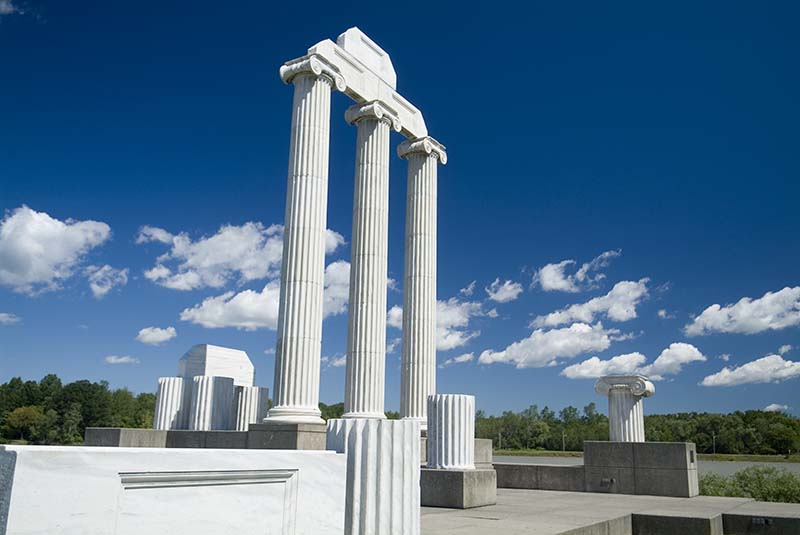Baird Point

Location: North
Historical Note:
The columns at Baird Point gracing Lake LaSalle on the North Campus were originally from the former Federal Reserve Bank on Main and Swan Streets in downtown Buffalo. Through the efforts of Cameron Baird and Major A. Burt Hamilton, the ionic columns from the bank's facade were secured for the University when the building was slated for destruction in 1959. Originally intended to be used as a backdrop for a proposed open-air Greek amphitheater on South Campus, they sat unused between Schoellkopf Hall and Baird Music Hall (today Allen Hall) for almost 18 years.
In 1978 the columns were cleaned and transported to Lake LaSalle on the relatively new North Campus. Baird Point, designed by Buffalo Architect Peter G. Castle, features the ionic columns on platforms of various heights with a focal point of three columns rising to a height of 35 feet above the base. Today Baird Point is still used as a place for "educational, cultural and social activities."
Namesake:
Baird Point was made possible by a gift from the Baird Foundation and the Cameron Baird Foundation.
Frank Burkett Baird (1852-1939) was an ironmaster and a pioneer in iron and steel. He served on the board of directors for the Pan American Exposition in 1901 and it was through his efforts that the Peace Bridge, connecting the city of Buffalo with Ontario, Canada, was built. Baird was a member of the University Council from 1920-1939, and a recipient of the 1927 Chancellor's Medal.
Cameron Baird (1905-1960), older son of Frank B. Baird, was known for his dedication to the Buffalo music community. A business-man early in his career, he worked for the family business, the Buffalo Pipe and Foundry Company. However, he also had a passion for music studying viola and music composition for many years. He was instrumental in establishing the Buffalo Philharmonic Orchestra Society along with Frederick C. Slee and Samuel P. Capen. In 1952 Cameron Baird founded the University's Music Department and was appointed its first Chairman.
William C. Baird (1908-1987), younger son of Frank B. Baird, was a well known and respected business man and philanthapist. In 1930 he joined the family business, the Buffalo Pipe and Foundry, later becoming the first president and then chairman of the board. For most of his life, Baird worked at making a better community for Buffalo and its environs. Continuing his father's association with the Peace Bridge, he served from 1939-1960 as bridge commission chairman. A true philanthapist, Baird helped organized the Butler Mitchell Boys Club and there is a Clubhouse named after him today. In 1967, he was awarded the Walter P. Cooke Award and an honorary degree in 1984.
History/Chronology:
- 1914 -- The Manufacturers and Traders Bank (M&T Bank) occupies the building on the corner of Main and Swan Streets in downtown Buffalo. Later it was owned by the Federal Reserved Bank.
- 1959 -- As the Federal Reserve Bank is slated for destruction, Cameron Baird and Air Force Major A. Burt Hamilton propose to secure the columns to be used as an amphitheater for UB.
- 1977 -- (December) The State University Board of Trustees officially accepts the gift from the Baird Foundation and the Cameron Baird Foundation to design an open air amphitheater on the North Campus using the columns from the former Federal Reserve Bank.
- 1978 -- (June 20) Groundbreaking.
- 1978 -- (September 10) Formal dedication of the Baird Point Amphitheater.
Original Architect: Peter Castle
Original Contractors: John W. Cowper Company, Inc. of Tonawanda
Original Size: 3,400 sq. ft.